Get new episodes right on your device by following us wherever you get your podcasts:
Click for the podcast transcript
The Scotiabank archives team is tasked with preserving Scotiabank’s history. They store and maintain digital records and documents. But that’s just the start.
“People just assume it's paper, but it's not, there's more to what we do and it really speaks to the history of the Bank,” said Christina Dinadis, the Senior Manager of Archives and Corporate records.
“There’s a lot of stuff out there that if you work for the Bank, if you work in a branch or in an office, stuff that you use every day, that is part of our experience at the Bank - that's the kind of stuff that I look at,” said Debbie Keffer, the Manager and Archivist of Scotiabank’s corporate history program. “So that if somebody 50 years from now wants to look back and say, ‘What was it like to work in a branch?,’ we have those pieces that we can then share.”
The following are some of Dinadis’ and Keffer’s favourite items from the archives collection. Objects that tell the story not only of Scotiabank, but of the history of banking in the last two centuries.
Also be sure to check out our story highlighting the evolution of Scotiabank’s brand identity over the years.
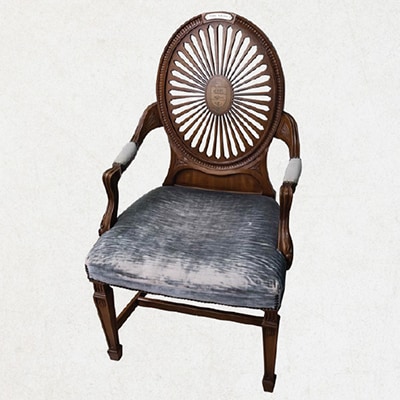
Marie Wilson Saunders’ board of directors chair, 1976
This chair belonged to Marie Wilson Saunders, who was the first woman to sit on the board of directors for the Bank of Nova Scotia, in 1976.
Scotiabank collection reference:
Object 0083. Part of RG001.
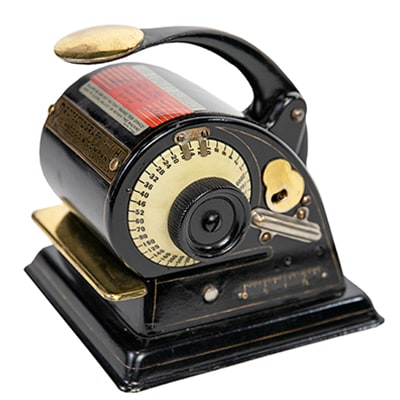
Protectograph, ca 1915
Protectographs were an early way to prevent fraud. Not only would they print the amount on a cheque or any item that needed to be legalized, they would also make an impression on the paper so the number couldn’t be erased and re-written.
Scotiabank collection reference:
Object 0028. Part of RG079.
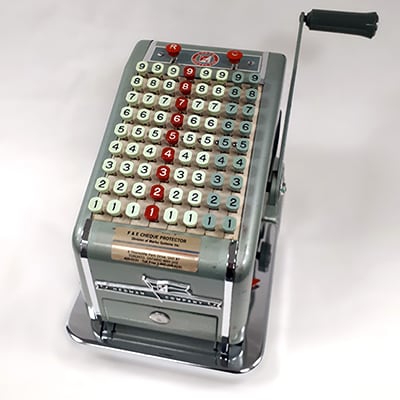
Protectograph, ca 1936
Scotiabank collection reference:
Object CHC-834.
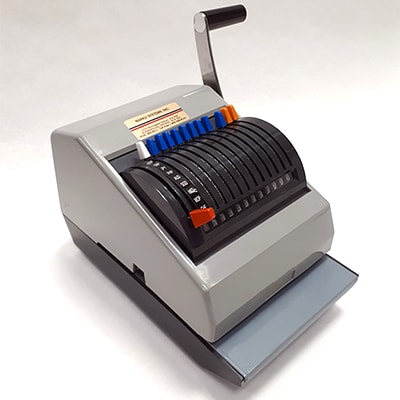
Protectograph, ca 2000
Scotiabank collection reference:
Object CHC-128.
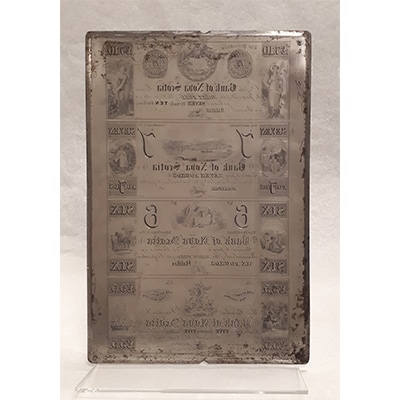
Banknote printing plate, 1840
Prior to the formation of the Bank of Canada in the 1930s, one of the main responsibilities of the banks was to print their own banknotes.
Scotiabank collection reference:
Part of RG006.
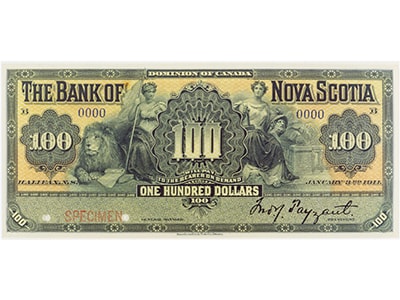
Bank of Nova Scotia banknote, 1911
Scotiabank collection reference:
Part of RG279.
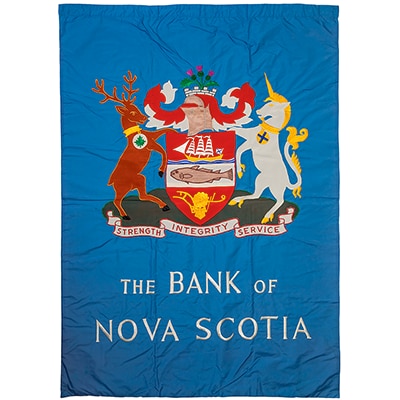
Bank of Nova Scotia flag, ca 1957
The first thing you may notice about this flag is that it’s blue. Scotiabank didn’t adopt its signature Scotia red until 1974.
The flag also shows off the bank’s coat of arms. One half represents the Scottish roots of Nova Scotia and the other half represents Canada as a whole. There’s a stag on one side wearing a maple leaf and a unicorn (the national animal of Scotland) on the other side wearing a St. Andrew's cross.
Scotiabank collection reference:
Part of RG001.
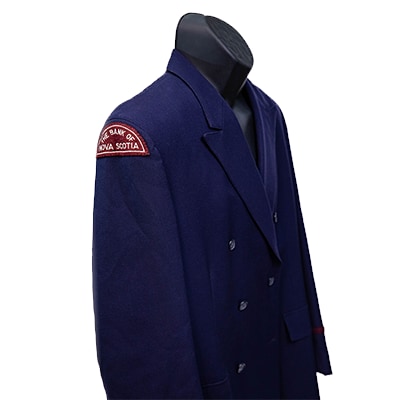
Scotiabank uniform jacket, 1964
This jacket was part of the uniform worn by certain employees at the bank, including security officers, messengers and armoured car drivers.
Scotiabank collection reference:
Object CHC-43.
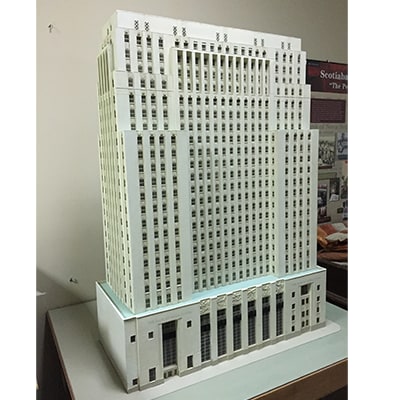
Architectural model of 44 King St. building, ca 1948
The Scotiabank building at 44 King St. opened in 1951. This model was on display in the former Scotiabank building leading up to the move to show employees, customers and guests what the new location would look like.
Scotiabank collection reference:
Object 0021. Part of RG016.
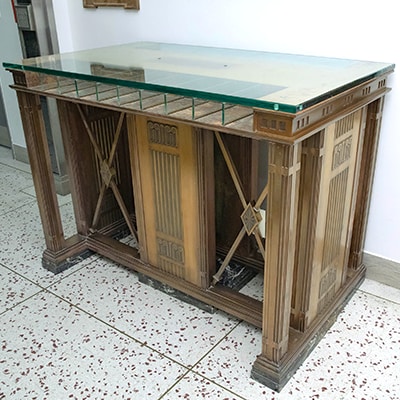
Bronze cheque desk, ca 1930
One of three cheque desks created specifically for the Granville and Davie Branch in Vancouver, B.C. The architects who designed the branch also designed the furniture. The column detail on the desk replicates the columns on the exterior of the branch.
Scotiabank collection reference:
Object 0033. Part of RG050.
Transcript:
Stephen Meurice: This episode we’re doing something unique for Perspectives. We’re getting out of the studio. Well, our home studio, anyway.
Like lots of Canadians we’re slowly getting back to the office. That’s actually where we recorded this episode.
And the timing couldn’t be better, because Scotiabank just celebrated its 190th anniversary. And to mark the occasion we’re going on a bit of a treasure hunt with some special guests.
Let’s get started.
Andrew Norton: Testing... checking the mic 1,2,3. Okay so rolling, whenever you’re ready...
SM: Okay, I’m here in the Scotiabank building in downtown Toronto with my producer, Andrew.
We’re in what was the original Scotiabank headquarters at 44 King Street. Right downtown where all the big banks are located. There’s a big stone engraving at the opposite end of this room. Lots of marble. It all looks very impressive and banky.
And it’s fitting we’re here because today is March 30, 2022, which is actually Scotiabank’s 190th anniversary.
So, we’re going to meet today with some people who are going to take us back through the bank’s history in a very hands-on way.
Christina Dinadis and Debbie Keffer are archivists here at Scotiabank. Debbie should be here any minute now.
They’re going to be walking us through some of their favourite items from the past couple of centuries. These are things that the public and even bank employees barely get to see, so it should be fun to get an insider’s look on some of the Bank’s history.
SM: And before we know it, our guide for the day is here. Debbie.
SM: Hey Debbie…
SM: She runs the corporate history program here at the bank. We follow her to the elevator.
[Sound of elevator opening]
Debbie Keffer: Going to the secret floor…
SM: She’s only half kidding. It’s not really secret, but we are headed to a part of the building that most employees probably don’t even know exists.
[Sound of elevator opening]
DK: So here we are.
SM: This ‘mystery floor’ is home to the Scotiabank archives. It’s run by Christina Dinadis
Christina Dinadis: Hello
SM: Hello, how are you doing?
SM: Christina and the archives team are tasked with preserving Scotiabank’s history. Storing digital records, documents. And that’s just the start.
CD: People just assume it’s paper, but it’s not, there’s more to what we do and really speaks to the history of the Bank.
DK: Yeah, basically so a lot of what I look at are things that maybe wouldn’t come naturally to the archive. There’s a lot of stuff out there that if you work for the Bank, if you work in a branch or in an office you use every day, that is part of our experience at the Bank — that’s the kind of stuff that I look at so that if somebody 50 years from now wants to look back and say, ‘what was it like to work in a branch? I mean what was a branch?’ we have those pieces that we can then share.
SM: And those pieces are housed just a few steps from where we’re standing, behind a non-descript office door that has the Scotiabank seal on it.
DK: So do you want to go see?
SM: And with the swipe of her card… we’re in.
[Sound of a door unlocking and opening.]
SM: The first thing you notice is the temperature change.
CD: So this room is climatized, when we walk in here we monitor the temperature and relative humidity on a daily basis. It’s all part of preservation.
SM: It looks like how you would picture an archive. There’s plenty of boxes on shelves. More than 1,000 of them. All meticulously labeled. There’s computers and scanners.
But most of the space is laid out like a museum exhibit. With artifacts in brightly lit display cases.
SM: And how do you find this stuff?
DK: I do a lot of outreach. So, when an office is moving or if I know that a branch is moving, I will reach out to the branch manager or to the person in charge of the office move, introduce myself and my program, tell them what I’m looking for and then as they clean up, I just asked them to set anything that they think is interesting aside.
SM: Part of Debbie’s job is figuring out what’s worth keeping, what’s something that’s going to tell a story about the Bank or what work was like in that era.
DK: Yeah, we get a lot of interesting items that, they’re not interesting now because we see them every day. But there’s a lot of stuff out there, that can be very evocative about a certain era. Like all I have to do is introduce somebody to an item that’s from the 1950s, and you immediately get this picture in your mind of, oh, well what would that work environment have been like? I think objects can do that in a sense.
CD: Brings you back in time.
DK: Yeah, little time machines.
CD: It is.
SM: And those time machines are all around us here. There’s a vintage burgundy security guard blazer. An original leather-bound, operations manual from 1885. And… is that a throne!?
CD: it is kind of like a throne. It’s a board of directors’ throne, actually.
SM: Wow.
CD: And whenever you became a member of the Bank’s board of directors, you actually got your own chair.
SM: It’s a brown wooden chair. Hand carved. With a well-worn green upholstered seat. It has small, metal plaque on it.
CD: You know when you’re a kid and they say to you, “That’s not your chair, it’s mine.” “Well, is your name on it? Well, yes it is.” They actually have their name put on the front of the chair. And that is Marie Wilson Saunders, who was the first female to sit on the board of directors for the Bank of Nova Scotia.
SM: And when was that?
CD: 1976
SM: Each item here has a story. But for someone like Christina, there’s often also a story behind how the item was acquired. And this chair is no exception.
CD: We got a call from somebody handling the estate of Marie Wilson Saunders and he said, you know, ‘We have this chair, do you want it? If you don’t come, we’re really just going to throw it in the garbage. It’s gone.’ I rushed to the house, picked up the chair, brought it back and me and the person handling the estate were actually walking through Scotia Plaza with this chair and there were the weirdest looks on people’s faces like, ‘What is happening?’ But all my years working for Scotiabank, every time I look at that chair, I think of walking through the banking hall and holding that, bringing it into the collection. It means a lot to me.
SM: Next, Debbie guides us over to another display.
DK: We can go over here and look at our protectographs.
SM: Protectographs?
DK: Yeah.
SM: On a table there’s three machines. The largest one sort of looks like if you combined an old typewriter, a graphing calculator on steroids and a slot machine, maybe?
DK: So, do you want to try one out?
SM: Sure!
DK: Okay, so these are protectographs, so it’s in the name: ‘protecto.’ They were a way to avoid fraud.
SM: It has a huge manual keypad and a big arm attached.
DK: If you were for example going to do a cheque or money order for a certain amount of money, you would enter the amount on this nice little keyboard here. I don’t know, we’re just going to push a bunch of buttons, and there’s our amount. And then you would insert your check, or whatever you were going to try and legalize, here and then you just crank the handle.
SM: Just like a slot machine.
[Sound of a heavy metal arm cranking.]
SM: And it has printed ‘Scotiabank. Banque Scotia,’ $1133.11.
DK: There you go. And if you notice it has a tactile element as well. So, it doesn’t just print, it punches the paper so that you can’t just erase the ink and rewrite the number. So, this was a way for the Bank to protect itself and its customers.
SM: These protectographs look super old school, but they were only decommissioned in 2018. Think how much banking technology has changed even in our lifetime.
DK: That’s because 40 years ago, we were pretty much a manual operation. It’s only within the past 40 years that we get things like bank machines and being able to go to any branch you want to do your banking and not just that one that has your signature card. And it’s amazing to think how quickly that has happened.
SM: And it’s not just the technology that’s evolved in the past 190-plus years. The money itself has changed. Debbie shows me another display.
DK: This is one of the items that is both unique to the Bank and also beautiful.
SM: It’s a steel plate… it looks almost like currency.
DK: And that’s exactly what it is. It’s a plate for printing banknotes. So, this is Bank of Nova Scotia money that we printed. One of the first things that the Bank did after it was founded was, go out and print a bunch of money.
SM: They could just make their own money?
DK: Banks did at the time — individual banks. It was one of their main responsibilities to print banknotes.
SM: So up until about the 1930s there wasn’t one standard set of paper money here in Canada like we’re used to.
If you say, wanted to buy a sack of potatoes or go for a nice carriage ride with the Mrs. on the promenade, or whatever people spent money on back then, you’d use a bill printed from your bank. Basically saying, “Hey, my bank’s good to give you this money.” And each institution had their own.
DK: Yes, so you would potentially have in your pocket banknotes from the Bank of Ottawa or the Bank of New Brunswick or the Bank of Nova Scotia.
SM: And they have a bunch of Bank of Nova Scotia bank notes right here in the archives.
By the way — fun fact to impress your friends, collecting currency or coins is called numismatics.
CD: Yes!
DK: Yeah, so this over here.
[Sound of metal drawer opening.]
SM: They look a lot like bills you might have in your wallet now. A little larger, though. But they have denominations printed on them, serial numbers and fancy pictures of politicians or guys on horses. Another big difference is that these are in Nova Scotia pounds and shillings. Remember, this is before the Bank of Canada.
Another thing that surprised me during our visit is about the Bank’s official seal. It’s something I’ve seen countless times but haven’t looked at too closely. Then Debbie just casually mentions there’s a Unicorn on it. And I’m like, wait –
SM: Unicorn?! There’s no unicorn.
DK: There is a unicorn.
SM: Our seal includes a unicorn?
DK: It does! It’s the national animal of Scotland. And so, one half of our coat of arms represents the Scottish roots of Nova Scotia where we were founded, and the other half represents Canada as a whole. So that’s why we have a stag on one side, and he wears a little maple leaf and the unicorn on the other side wears a St. Andrew’s cross around his neck to symbolize Scotland.
SM: And to prove it, Debbie shows me an old Scotiabank flag that would have hung at a branch. And — yeah — there it is, a unicorn.
DK: Yes. it’s fairly common. It’s a traditional heraldic symbol.
SM: And of course, the flag is the colour we all now associate with the Bank. The iconic Scotiabank… blue?!
DK: It’s blue! We think of Scotia red, but that’s a fairly new thing. It was in the 1970s that we adopted red as our colour. Before that, this vibrant blue was very much more what you would see in terms of our branding. And that was when we also adopted our ‘flying S’ that we all know and love so much.
SM: We could probably spend all day going through the drawers and boxes and displays. We’ve only been here for an hour, but it doesn’t take long to understand the importance of the collection.
Sure, it keeps records safe. But it also provides a tactile history on how banking has evolved. The history of currency. Canadian politics. Gender politics. Technology. Even fashion.
It’s a living, evolving document of the bank itself. And that’s especially poignant given the day that we’re visiting.
SM: So, we’re here in the context of the Bank’s 190th anniversary. So, it’s a very old institution older than the country even. What are the historical things that have struck you about the Bank over the course of that time?
DK: Well for me there’s been a couple of things. You know, we’ve changed immensely in terms of how we operate and who we are as a bank, but a lot of our principles are still the same as they were. A lot of the same things that we hold important today were things that were part of our founding principles.
CK: The 190th to me really helps solidify what the archives is and help to preserve the history of the Bank and to show that a lot of the work that we’re doing in here has value over time and will continue to grow and evolve. So, stay tuned for the 200th.
SM: Do you think about whatever person is going to be doing your jobs 100 years from now? Do you think about them when you’re making decisions about what to keep? What are the things that will tell the story of 2022 in 2122?
DK: I do all the time. I run the corporate history program, but I spend as much of my time, I think, probably looking forward and encouraging people to think forward about the things that you are seeing every day that are going to be the artifacts of tomorrow. We don’t know which things are necessarily going to disappear. We might have some clues about certain things, but we’re always — I at least am —always thinking about what’s going to be missing. I try and get out there and find those missing pieces before they’re gone.
SM: We want to thank our guests again — Christina Dinadis, the Senior Manager of Archives and Corporate records, and Debbie Keffer, the Manager and Archivist of Scotiabank’s corporate history program.
We’ll have photos of all the items we learned about — and even some we didn’t have time for — up on the story page for this episode. You can find that at Scotiabank.com/perspectives. We’ll put a link in the description, too. We also have a great story up now about the evolution of the Scotiabank logo. Check that out if you haven’t already, we’ll link to that as well.





